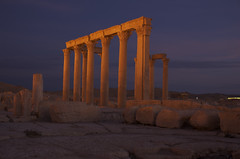Yesterday, I had lunch at the Union. I got a burger from the barbecue and a large cup of cola, but that was not the reason I was there. Far greater appeal had the large screen hanging from a side wall of the student bar. All World Cup matches are projected there, and yesterday, Germany was playing Serbia. After the damage the Germans inflicted on the hapless Australians in the first game, I was justifiably excited, and looking forward to a continuation of the glory. I was in good company; the room was filled with a cheering crowd of compatriots.
The cheering turned into stunned silence first and then into angry shouts. The game started poorly, less spectacular action in the box than continuous inept tackles. The ref seemed as baffled as the audience and tried, by handing out harsh punishments, to steer the game to where it should have been. Serbia and Germany saw plenty of yellow cards until, to our complete astonishment, the German striker Klose saw his second and was excused from further participation. Shortly thereafter, the Serbs scored. It was to be the only goal of the game, despite some inspired efforts by the Mannschaft. But they didn't seem to wear their winning boots that afternoon. Even a penalty wasn't enough to equalize the game. An hour after finishing the burger, my mood had turned sour and I had to return to work.
I didn't go back to my lab, though. Earlier, on my way to the Union, I had made a detour to the Bioengineering building to do an enzyme assay. I had carried with me an ice box with a few little tubes inside and a sheet with careful instructions, scribbled in code illegible for anyone but me. If you know a little about biochemistry, you probably think you know what I'm talking about. Add substrate to the enzyme you study, start the reaction by transfer to the right temperature, by addition of ATP or a pulse of light, and observe the development of the signal over time. This is how the textbooks describe it.
My assay was a bit more involved. The enzyme under study is a large oligomer, but it doesn't do much by itself. It needs a accessory complex for activity against what we think might be physiological substrates. Another protein of more than two dozen subunits is needed to clear the substrate of that reaction; otherwise no signal can possibly be observed. With so many components, the little reaction vessel I put into the analyzer came closer to a cell's make-up than most assays, though of course it remained artificially short. Science is, after all, divide and conquer most of the time.
When I returned to my experiment after the game, the assay was done and the results very encouraging. I took the data back to the main lab and prepared another assay, with a few controls. In the process, I was getting rather excited – certainly more than I had been during the game earlier. We had purified the main enzyme, a long-standing object of the lab's interest, and also the accessory proteins. The clearing complex came from a collaborator in the US. So did one of our substrates, but from a different lab. The other substrate was provided by scientific contacts in the North. As I combined the solutions for the second experiment, I counted the different places and people involved. My not-so-little assay was all but a global effort.
While the US tried its best not to lose to Slovenia (ultimately successfully) in the afternoon game, my assay progressed, and when I returned to get the numbers, they confirmed what I had seen earlier. It looked like we were really up to something. My boss, alerted by an email with a little Excel chart attached, came over to my desk, bouncing with possibility. He was imagining all the mutants we could test, all the other combinations of ingredients, possibly other substrates. For him, the sky is never the limit. We had a few jolly moments of joined enthusiasm but adjourned further discussion until after the weekend, as both of us wanted to go home – and watch the third game of the day.
England was playing Algeria. Normally, for the evening games, I would go to The Famous Three Kings, a pub that used to be, under a different name, a punk music venue in the 70s and is immortalized as such in Hanif Kureishi's The Buddha of Suburbia. Now it is widely known as a sports bar that caters to all fans with blissful disregard of their colors. World Cup games are shown on gigantic screens in both teams' languages. One half of the pub is filled with supporters of one team, the other half with their opponents. It's always a great atmosphere, but as England were playing, it would be impossible to get in.
Instead, I decided to go to The Goose, the pub across the street that I only recently discovered. It's a nice enough pub but completely free of pretense, old-school but not traditional in a historic way. Its large and spacious interior suggests a living room, and indeed pubs used to provide poorer people with the space they lacked in their cramped apartments. The Goose preserves this long-gone era. You can go have a beer and then sit there for hours and read a newspaper. The only people disturbing you would be other regulars greeting you. In line with its down-to-earth vibe are the food and drinks prices that are almost cheaper than reasonable and the very warm staff. It might not be the best venue for football, but it's a good place to hang out for an hour or two, and this was exactly what I needed given that the game was short of highlights and ended in a dissatisfying goalless draw.

No comments:
Post a Comment